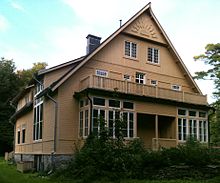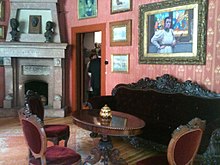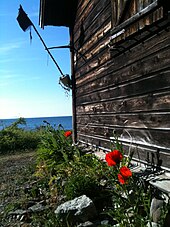Brucebo
Brucebo is the name of a country estate on the Swedish island of Gotland . The property belongs to the village of Väskinde and is located about eight kilometers north of Visby . The artist couple Carolina Benedicks-Bruce and William Blair Bruce lived here from 1900, and they expanded the house considerably, bought additional buildings or built new ones. Large parts of the property have been protected as the Brucebo nature reserve since 1970 and are now part of the Gotland community . The Brucebo Foundation (Brucebostiftelsen) has been awarding grants since 1937 to young artists who can use various Brucebo buildings as living and working spaces. The Swedish film producer and director Torbjörn Axelman lived in the former Brucebo house for 35 years, who shot several people when the house was cleared in 2008. After extensive renovation work, the building, maintained by the Brucebo Foundation, has been open to the public as the Museum Konstnärshemmet Brucebo since 2012 and shows the artistic work of the Benedicks-Bruce couple.
history
Artist house for William Blair Bruce and Carolina Benedicks-Bruce
The Brucebo country estate in the village of Väskinde on Gotland was the residence of the Swedish sculptor Carolina Benedicks-Bruce and her Canadian husband, William Blair Bruce. Carolina Benedicks-Bruce visited Gotland with her family as a child and later returned with her husband. Both first came to the island together in 1888. William Blair Bruce was enthusiastic about the landscape and wrote to his mother that the island would remind him of Canada. Carolina Benedicks-Bruce came from a wealthy entrepreneurial family and had sufficient financial means to purchase various properties near the village of Väskinde from the late 1890s. In 1900 they also bought the Emilsro summer house near the fishing port Själsö, which had previously belonged to the family of the teacher Elof Wisselgren. The Wisselgrens named the house after their daughter Emilie. The new owners gave the property the name Brucebo, which roughly means the house where Bruce lives .
The Benedicks-Bruce couple moved into Brucebo in June 1900. William Blair Bruce, who originally worked as an architect, planned significant renovations and extensions that were not fully completed until 1909. He oriented himself here on the style of the Nordic national romanticism . The extension building received a wooden facade like the one in the original building. The rooms were equipped with richly decorated fireplaces, which indicates that the house was to be used all year round from the start. In the annex, a two-storey studio was created with large windows that provided a view of the nearby Baltic Sea. In addition to living rooms, there is a library, a kitchen, the owner's bedroom and several guest rooms. One of the special features of the house is the Indianrummet (Indian room ), in which there are Indian portraits painted by William Blair Bruce and other memorabilia from Canada. In front of the house, the owners created a terrace with a view of the sea. In addition, a garden pavilion, a studio building on the beach, an ice cellar, a stable building and a house called Korsvirkeshuset for the employees were built.
William Blair Bruce died in 1906 and was buried in the Väskinde cemetery. In their six years together in Brucebo, the two artists created an extensive oeuvre. Due to their wealth, they were independent of the sale of their work, so that many of the works remained in their possession. They are still in Brucebo's house to this day. Carolina Benedicks-Bruce continued to live in Brucebo after the death of her husband. She had the old outhouse Skogsateljén converted into a forest studio. In addition, they bought more adjoining land until 1920, so that Brucebo grew to a total of 35 hectares .
Carolina Benedicks-Bruce invited numerous guests to Brucebo. When an international conference for the introduction of women's suffrage was held in Stockholm in 1911 , she received numerous delegates at her property. The visitors to Brucebo in the following years included the Swedish Archbishop and later Nobel Peace Prize winner Nathan Söderblom , the young Raoul Wallenberg , the then Crown Prince Gustav Adolf and the future Danish Queen Ingrid . There were also musicians like the violinist Nora Duesberg from Vienna and the composer Friedrich Mehler , who met his future wife on Brucebo. Mehler composed the piano piece Brucebo here in 1923 . In addition, the Swedish painter Hjalmar Strååt (1885–1971) was a guest on Brucebo for some time. He lived in the fisherman's hut Fiskarstugan and created several paintings with motifs by Brucebo. Carolina Benedicks-Bruce died in 1935 and was buried in the Väskinde cemetery.
Bruce as a guest house
Since Carolina Benedicks-Bruce had no direct heirs, they bequeathed Brucebo with the buildings and the art collection of the Brucebostiftelsen, which she founded . The Brucebo Foundation has been awarding grants to young artists since 1937 to stay on Brucebo so that they can live and work here during the summer months. Initially, only Swedish artists came to the island, as there was initially no money available for the expensive journey from Canada. Initially, the living room and the large studio in the main house served as dining rooms, while the other rooms were used as bedrooms. With the beginning of the Second World War in 1939 Brucebo was closed and not used for the next few years. It was not until 1946 that Swedish scholarship holders came to Brucebo again. Since 1966 there have also been Canadian scholarship holders who have been accommodated in the former fisherman's house Fiskarstugan since then . Swedish scholarship holders have lived in the former farmhouse Fiskarstugans ladugård since 1969 . The works of art created during the stay can then be seen in exhibitions at the Visby Art Museum. Since 1995 there has also been the William Blair Bruce's European Fine Art Travel Scholarship for students from Canada, which includes a travel allowance for a European trip and a visit to Gotland. In addition, there has been an exchange program between the Landschaftsverband Westfalen-Lippe in Germany and the Swedish municipality of Gotland since 1976 , which hosts students from the other country. The students from Germany live in studio houses on Brucebo.
When there was an urgent need for renovation in 1971, the foundation board decided not to invest any more money in the renovation of Brucebo's main building. Brucebo turned out to be uneconomical as the scholarship holders only came in the summer months and other rentals brought little income. In contrast, there were considerable personnel and maintenance costs. The foundation therefore decided to sell a large part of Brucebo. With the money raised, the scholarship program should be permanently secured. It was also planned to keep the smaller buildings for the scholarship holders.
Torbjörn Axelman in Brucebo
In 1972 the Brucebo Foundation sold the majority of the property to the Gotland community . This means that large areas of the landscape that have been designated as the Brucebo nature reserve since 1970 became the property of the municipality. Brucebo's main house was also up for sale, but the interior furnishings with the art collection remained with the Brucebo Foundation. This also kept the former fisherman's house and smaller outbuildings.
In 1973 the community sold the main Brucebo house for 300,000 Swedish kronor to the television producer, director and author Torbjörn Axelman . He had been a regular guest on Brucebo since 1963 and lived in the fisherman's house at that time. He made several films on Gotland, including Lejonsommar in 1968 with the actors Sven-Bertil Taube , Essy Persson , Ulf Brunnberg and Margareta Sjödin . In 1975 the Swedish film Må vårt hus förskonas från tigrar was made on the island. Axelman was a director and producer; he wrote the script together with the American singer Lee Hazlewood . Both also appeared as actors in the film. Hazlewood also wrote the score for the film, which he released under the English title A House Safe for Tigers . The song Souls Island contained therein was about the island of Gotland and the record cover shows Axelman and Hazlewood in the Brucebo house. Axelman ended his collaboration with Swedish television in the 1980s . He wrote several poems in Brucebo which were published as Själsö elegien . He also painted some pictures here. After his film company had to file for bankruptcy in 1995, he sold the main Brucebo house to the Brucebo Foundation a little later, but stayed in the house. The public could not visit the house during this time.
The Foundation will terminate Axelman's tenancy at the end of September 2008. The foundation cited outstanding rent payments and the urgent need for renovation of the house as the reason for this. On December 1, 2008, a criminal case occurred in the house and the surrounding area that attracted attention in Sweden: In the morning of the day, the chairman of the Brucebo Foundation, Joakim Hansson, appeared with his secretary Hanne Ödin and four other helpers to remove works of art from Brucebo. The William Blair Bruce paintings and Carolina Benedicks-Bruce sculptures in question were owned by the Foundation and were to be inventoried and cleaned prior to the renovation of the building outside Brucebo. That afternoon there was an argument between Axelman and Hansson in Brucebo's kitchen. In the course of this, Axelman shot Hansson several times and hit him in the back and in the hand. Hansson was able to save himself seriously injured from the house and collapsed on a lawn near the house. Axelman initially stayed in the house. When a police incident arrived later, Axelman left the house with a gun and shot the police officers who returned fire. Axelman was seriously injured and the police officers were not injured. Both Axelman and Hansson survived the shootout. The district court in Visby, like other instances later, certified the 76-year-old Axelman with mental illness. He was convicted of three counts of attempted murder. He then spent some time in a closed psychiatric facility. Axelman has lived in Stockholm since 2011 and, according to the court order, is no longer allowed to visit Gotland.
Brucebo as a museum
After Torbjörn Axelman moved out, the building was completely cleared. The extensive renovation included a new heating system and new electrical systems. Even the garden, which had overgrown over the years, could almost be restored to the state it had looked in the days of Carolina Benedicks-Bruce. After the work on the house was completed in 2010, the interior including the restored works of art by the Benedicks-Bruce couple returned to their original location. The paintings and sculptures, but also furnishings such as the grand piano on which William Blair Bruce once played, give an impression of the life of the two artists in Brucebo. In 2011, the Brucebo Foundation offered guided tours of the house, during which the public had the first opportunity to view the house and the collection. Brucebo has been open to visitors regularly as a museum since 2012.
literature
- Gunvor Bonds: William Blair Bruce, Caroline Bendicks och Brucebo . Bonds, Stockholm 1977.
Web links
- Official website (Swedish)
- Detailed description of Brucebo on the website www.sjalsohamn.se (Swedish)
- Information about Brucebo on the website www.gotland.net (Swedish)
Coordinates: 57 ° 41 ′ 17.8 ″ N , 18 ° 21 ′ 9.5 ″ E





